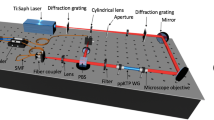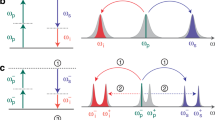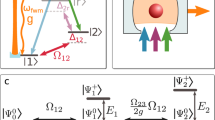Abstract
A microscopic quantum system under continuous observation exhibits at random times sudden jumps between its states. The detection of this quantum feature requires a quantum non-demolition (QND) measurement1,2,3 repeated many times during the system’s evolution. Whereas quantum jumps of trapped massive particles (electrons, ions or molecules4,5,6,7,8) have been observed, this has proved more challenging for light quanta. Standard photodetectors absorb light and are thus unable to detect the same photon twice. It is therefore necessary to use a transparent counter that can ‘see’ photons without destroying them3. Moreover, the light needs to be stored for durations much longer than the QND detection time. Here we report an experiment in which we fulfil these challenging conditions and observe quantum jumps in the photon number. Microwave photons are stored in a superconducting cavity for times up to half a second, and are repeatedly probed by a stream of non-absorbing atoms. An atom interferometer measures the atomic dipole phase shift induced by the non-resonant cavity field, so that the final atom state reveals directly the presence of a single photon in the cavity. Sequences of hundreds of atoms, highly correlated in the same state, are interrupted by sudden state switchings. These telegraphic signals record the birth, life and death of individual photons. Applying a similar QND procedure to mesoscopic fields with tens of photons should open new perspectives for the exploration of the quantum-to-classical boundary9,10.
This is a preview of subscription content, access via your institution
Access options
Subscribe to this journal
Receive 51 print issues and online access
$199.00 per year
only $3.90 per issue
Buy this article
- Purchase on Springer Link
- Instant access to full article PDF
Prices may be subject to local taxes which are calculated during checkout




Similar content being viewed by others
References
Braginsky, V. B. & Khalili, F. Y. Quantum Measurement (ed. Thorne, K. S.) Chs IV and XI (Cambridge Univ. Press, Cambridge, UK, 1992)
Grangier, P., Levenson, J. A. & Poizat, J.-P. Quantum non-demolition measurements in optics. Nature 396, 537–542 (1998)
Nogues, G. et al. Seeing a single photon without destroying it. Nature 400, 239–242 (1999)
Peil, S. & Gabrielse, G. Observing the quantum limit of an electron cyclotron: QND measurements of quantum jumps between Fock states. Phys. Rev. Lett. 83, 1287–1290 (1999)
Nagourney, W., Sandberg, J. & Dehmelt, H. Shelved optical electron amplifier: Observation of quantum jumps. Phys. Rev. Lett. 56, 2797–2799 (1986)
Sauter, T., Neuhauser, W., Blatt, R. & Toschek, P. E. Observation of quantum jumps. Phys. Rev. Lett. 57, 1696–1698 (1986)
Bergquist, J. C., Hulet, R. G., Itano, W. M. & Wineland, D. J. Observation of quantum jumps in a single atom. Phys. Rev. Lett. 57, 1699–1702 (1986)
Basché, T., Kummer, S. & Bräuchle, C. Direct spectroscopic observation of quantum jumps of a single molecule. Nature 373, 132–134 (1995)
Haroche, S. & Raimond, J. M. Exploring the Quantum (Oxford Univ. Press, Oxford, UK, 2006)
Raimond, J. M., Brune, M. & Haroche, S. Manipulating quantum entanglement with atoms and photons in a cavity. Rev. Mod. Phys. 73, 565–582 (2001)
Schuster, D. I. et al. AC-Stark shift and dephasing of a superconducting qubit strongly coupled to a cavity field. Phys. Rev. Lett. 94, 123602 (2005)
Schuster, D. I. et al. Resolving photon number states in a superconducting circuit. Nature 445, 515–518 (2007)
Kuhr, S. et al. An ultrahigh Finesse Fabry-Perot superconducting resonator as a photon box for cavity-QED experiments. Preprint at 〈http://arxiv.org/cond-mat/0612138〉 (2006)
Brune, M., Haroche, S., Lefèvre, V., Raimond, J. M. & Zagury, N. Quantum non-demolition measurement of small photon numbers by Rydberg atom phase-sensitive detection. Phys. Rev. Lett. 65, 976–979 (1990)
Brune, M., Haroche, S., Raimond, J. M., Davidovich, L. & Zagury, N. Quantum-non demolition measurements and generation of ‘‘Schrödinger cat’’ states. Phys. Rev. A 45, 5193–5214 (1992)
Carmichael, H. J. An Open System’s Approach to Quantum Optics (Springer, Berlin, 1993)
Benson, O., Raithel, G. & Walther, H. Quantum jumps of the micromaser field: Dynamic behavior close to phase transition points. Phys. Rev. Lett. 72, 3506–3509 (1994)
Haroche, S., Brune, M. & Raimond, J. M. Measuring photon numbers in a cavity by atomic interferometry: optimizing the convergence procedure. J. Phys. II France 2, 659–670 (1992)
Buzek, V. & Knight, P. L. Quantum interference, superposition states of light, and non-classical effects. Prog. Opt 34, 1–158 (1995)
Lutterbach, L. G. & Davidovich, L. Method for direct measurement of the Wigner function in cavity QED and ion traps. Phys. Rev. Lett. 78, 2547–2550 (1997)
Bertet, P. et al. Direct measurement of the Wigner function of a one-photon Fock state in a cavity. Phys. Rev. Lett. 89, 200402 (2002)
Davidovich, L., Brune, M., Raimond, J. M. & Haroche, S. Mesoscopic quantum coherences in cavity QED: Preparation and decoherence monitoring schemes. Phys. Rev. A 53, 1295–1309 (1996)
Nielsen, M. A. & Chuang, I. L. Quantum Computation and Quantum Information (Cambridge Univ. Press, Cambridge, UK, 2000)
Acknowledgements
We acknowledge funding by ANR, by the Japan Science and Technology Agency (JST), by the EU under the IP projects ‘QGATES’ and ‘SCALA’, and by a Marie-Curie fellowship from the European Community (S.K.). We thank P. Bosland, E. Jacques and B. Visentin for the niobium sputtering of the mirrors, and Thomas Keating Ltd for providing radar absorbing material. Author Contributions S.G. and S.K contributed equally to this work.
Author information
Authors and Affiliations
Corresponding author
Ethics declarations
Competing interests
Reprints and permissions information is available at www.nature.com/reprints. The authors declare no competing financial interests.
Rights and permissions
About this article
Cite this article
Gleyzes, S., Kuhr, S., Guerlin, C. et al. Quantum jumps of light recording the birth and death of a photon in a cavity. Nature 446, 297–300 (2007). https://doi.org/10.1038/nature05589
Received:
Accepted:
Issue Date:
DOI: https://doi.org/10.1038/nature05589
This article is cited by
-
Time-series quantum reservoir computing with weak and projective measurements
npj Quantum Information (2023)
-
Parallel tomography of quantum non-demolition measurements in multi-qubit devices
npj Quantum Information (2023)
-
Metasurface-stabilized optical microcavities
Nature Communications (2023)
-
Splitting Photons into Pair Photons to Design a High-Performance Printable Solar Cell
Silicon (2023)
Comments
By submitting a comment you agree to abide by our Terms and Community Guidelines. If you find something abusive or that does not comply with our terms or guidelines please flag it as inappropriate.



